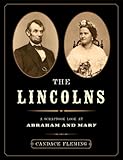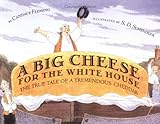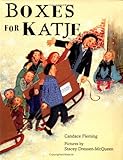
Dewey: 973.7092

The Lincolns: A Scrapbook Look at Abraham and Mary by Candace Fleming, Schwartz & Wade, 2008


Candace Fleming has a gift for finding those stories in history that would be lost to children if she did not tell them.
A Big Cheese for the White House: The True Tale of a Tremendous Cheddar and Boxes for Katje are two of my favorite Fleming books.
Here, Fleming focuses on the Lincoln's personal life, telling the story in a scrapbook format.
My own family has a scrapbook that was kept by my great-grandmother while living on the Wyoming frontier in the late 19th century. The look of this book bears a strong resemblance to that family heirloom with clippings from magazines and newspapers papers that give a feel for the time. The book design and even the typeface, Old Times American, brings the 1800's to life.
Fleming has included material from letters and archives that paint a picture of Lincoln family life. Her notes and picture credits at the end of the book testify to her research. Period photographs, cartoons, and illustrations carry the reader through their story, from start to finish but also invite browsing for an odd fact or two.
My original plan to skim through the book was, thankfully, defeated by Fleming's clear and engaging writing which sent me scurrying back to the beginning to read the whole thing.
The outlines of Abraham and Mary Todd Lincoln's lives are generally known. "The rest of the story" that is presented here makes for fascinating reading.
I did NOT know:
- that Abe's relationship with his father was so poor that he did not attend his father's funeral
- that he devised and patented a devise to lift boats over sandbars and shallows but never developed or tested the idea commercially
- that his law practice, before entering politics, was highly successful and very profitable (makes sense but the image of Henry Fonda in Young Mr. Lincoln, riding that mule is strong)
- that he returned all campaign donations, except for $.75, to his political supporters, thanking them and explaining that he had not need the extra money.
Oh, if ONLY that were true today, a model for us all!
Personally, I have always believed that Mary Lincoln's image and memory were misunderstood and abused by her contemporaries and by history. The reader will feel deep empathy for this woman who lost her children to typhoid and pleurisy and saw her husband murdered, before her eyes.
- The image of her recipe for white cake, "from the kitchen of Mrs. Lincoln and pages from Godey Lady's Book give the reader an feel for what her daily life was like.
- Fleming presents the reader with the Lincoln's wedding certificate and, later, the headlines about the trial that resulted in her commitment to an insane asylum by her son, Robert.
- There is no doubt Mary Lincoln was unconventional and difficult. I cheered though, at the story of her emerging from her deep grief following the assassination, to thwart the self aggrandizing plans of the Springfield community leaders who were ignoring her and the President's wishes for his final resting place.
- Mary's desperation to escape her incarceration in the asylum drove her to cannily contact a leading woman lawyer who took up her cause and helped free her.
I recommend using this as a nonfiction class read-aloud. Educators who are worried about standardized tests need to model nonfiction reading for students.
Candace Fleming, what an outstanding achievement!
No comments:
Post a Comment